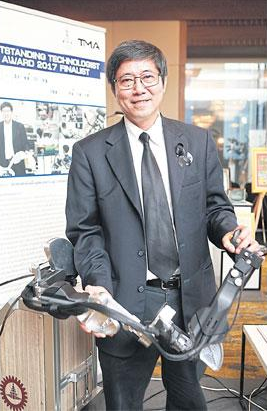
New robot technology help for stroke sufferers in Thailand
New tech which would be especially helpful for the underprivileged receives more than US$900,000 funding for research and public hospital use

By Suchit Leesa-Nguansuk
Patients suffering a stroke often feel hopeless. With a lengthy rehabilitation period not to mention other treatments, they usually see themselves as having little chance of a full recovery.
Exoskeleton for rehabilitation in stroke patients or so-called Robotic Assistant Therapy, which was developed by the winner from the Outstanding Technologist Award 2017 in Thailand, gives new hope to stroke patients, especially those who are on a low income. It was supported by the National Research University Project under the Office of Higher Education Commission and Bangkok’s Chulalongkorn University.
“We received 30 million baht (US$904,000) funding to develop this research and were selected to install it at public hospitals where underprivileged patients who cannot afford therapists come for treatment,” said Viboon Sangveraphunsiri, Department of Mechanical Engineering, Faculty of Engineering Chulalongkorn University. Viboon is the researcher who owns this project.
In normal cases, physical rehabilitation is paramount for patients falling victim to stroke, especially within the first six months. Therapy with a trained professional is of course the best approach but Thailand — home to more than 500,000 stroke patients countrywide — has a shortfall, while still facing 200,000 new patients each year.
The treatment of stroke patients nationwide requires a budget of around 20 billion baht per year. These patients lose around 7.1 billion baht per year on a national scale. The lack of human therapists is a barrier to patient recovery. They only have a five-20 per cent chance of a full recovery. The reminder of patients are still weak, given insufficient human resources and equipment.
The advent of robot-assisted therapy is therefore useful even for patients after their first six months. Those suffering a stroke three years beforehand can also benefit from the technology which can help make up for the shortage of therapists, mostly in private hospitals.
The new robot-assisted therapy can offer a variety of rehabilitation techniques depending on the organs that need to be rehabilitated — ranging from wrist rehabilitation, end-effector and lower limb exoskeleton robots.
“The production of this assistive robot therapist costs around 500,000-600,000 baht(US$15,000-US$18,000), which is over 10 times lower than imported devices. We focus on placing such technology in public hospitals,” said Viboon.
Currently, the technology is used at Chulalongkorn Hospital. It has been found that after undergoing rehabilitation by the assistive robot therapist, young stroke patients between the ages of 19 and 23 can often make a full recovery as their brain can be trained and rehabilitated faster when compared to elderly people.
Robot therapists have clinical tests by working with medical doctors to find out the results and feedback for technology improvement. Doctors decide which patient can undergo the robot-assisted therapy. The robot is apparently a promising method for promoting motor recovery in patients with a neurological deficit.
One main control strategy of the robots is Active Assistive Control strategy, which is available in both assistive and resistive mode. This is for patients who have some difficulty in moving their hands or have a physical weakness.
Another method is resistive mode for patients who want to improve hand motion or who have finished the assistive-resistive operation training programme. Each joint of the exoskeleton arm is actuated by a brushlessDC servomotor.
The exoskeleton arm has a robot controller unit that can show the results of patients during training or exercise on a large monitor. Patients can see how close they are to a pre-specified path.
The robot also benefits from simple installation. It can support personalised training for each patient through programming.
It is expected that the robot-assisted therapists will open for other universities to assemble and install more in other public hospitals.